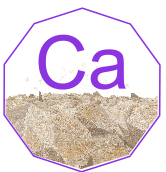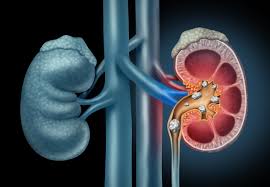Calcium

Calcium: Element Overview
Basic Information
- Symbol: Ca
- Atomic Number: 20
- Atomic Weight: 40.078 u
- Element Category: Alkaline earth metal
- Group: 2
- Period: 4
Physical Properties
- Phase at Room Temperature: Solid
- Melting Point: 842 °C (1548 °F)
- Boiling Point: 1484 °C (2703 °F)
- Density: 1.54 g/cm³ at 20 °C
- Color: Silvery-white
- Crystal Structure: Face-centered cubic (fcc)
Chemical Properties
- Electronegativity: 1.00 (Pauling scale)
- Ionization Energies:
- First: 589.8 kJ/mol
- Second: 1145.4 kJ/mol
- Third: 4912.4 kJ/mol
- Reactivity: Reacts readily with water, producing calcium hydroxide and hydrogen gas; also reacts with oxygen to form calcium oxide.
Isotopes
- Stable Isotopes: Calcium has six stable isotopes: Ca-40, Ca-42, Ca-43, Ca-44, Ca-46, and Ca-48.
- Ca-40: 96.941%
- Ca-42: 0.647%
- Ca-43: 0.135%
- Ca-44: 2.086%
- Ca-46: 0.004%
- Ca-48: 0.187%
Occurrence and Production
- Natural Abundance: Calcium is the fifth most abundant element in the Earth’s crust.
- Sources: Found in minerals like limestone (calcium carbonate), gypsum (calcium sulfate), and fluorite (calcium fluoride).
- Production: Produced by electrolysis of molten calcium chloride or by thermal reduction of lime with aluminum.
Uses and Applications
- Construction: Used in the production of cement and concrete, as well as in the manufacture of lime (calcium oxide).
- Agriculture: Used in the form of calcium carbonate as a soil conditioner and fertilizer.
- Food Industry: Essential nutrient in human diet, found in dairy products, leafy greens, and fortified foods.
- Medical: Used in antacids (calcium carbonate) and as a supplement for bone health.
- Industrial: Used as a reducing agent in the extraction of other metals, and in the manufacture of various chemicals and compounds.
Safety and Precautions
- Reactivity: Calcium metal is reactive and should be handled with care, especially around water and acids.
- Handling: Should be stored in an airtight container to prevent oxidation.
- Health: Calcium compounds are generally safe, but excessive intake of calcium supplements can cause health issues like kidney stones.
Biological Role
- Essential Element: Calcium is vital for all living organisms.
- Bone Health: Critical component of bones and teeth.
- Cell Function: Involved in muscle contraction, nerve function, and blood clotting.
- Enzyme Activity: Acts as a cofactor for many enzymes.
Historical Background
- Discovery: Recognized as an element in 1808 by Sir Humphry Davy.
- Naming: The name “calcium” comes from the Latin word “calx,” meaning lime.
Interesting Facts
- Calcium Compounds: Calcium carbonate is used to produce lime, which is crucial in the steel industry.
- Bone Composition: Bones are primarily composed of calcium phosphate.
- Calcium in Water: Contributes to water hardness, leading to scale formation in pipes and boilers.
Summary
Calcium is an essential alkaline earth metal known for its role in biological systems and wide range of industrial applications. It is abundant in the Earth’s crust and is crucial for bone health, muscle function, and various metabolic processes. Discovered in the early 19th century, calcium is used in construction, agriculture, food, and medicine, making it a vital element in both natural and human-made environments.
Questions and Answers about Calcium:
Q: What is the chemical symbol for Calcium?
- A: Ca
Q: What is the atomic number of Calcium?
- A: 20
Q: What type of element is Calcium?
- A: Alkaline earth metal
Q: What is the atomic weight of Calcium?
- A: 40.078 u
Q: What group is Calcium in?
- A: Group 2
Q: What period is Calcium in?
- A: Period 4
Q: What is the phase of Calcium at room temperature?
- A: Solid
Q: What is the melting point of Calcium?
- A: 842 °C (1548 °F)
Q: What is the boiling point of Calcium?
- A: 1484 °C (2703 °F)
Q: What is the density of Calcium at 20 °C?
- A: 1.54 g/cm³
Q: What is the color of Calcium metal?
- A: Silvery-white
Q: What is the crystal structure of Calcium?
- A: Face-centered cubic (fcc)
Q: What is the electronegativity of Calcium?
- A: 1.00 (Pauling scale)
Q: What is the first ionization energy of Calcium?
- A: 589.8 kJ/mol
Q: How many stable isotopes does Calcium have?
- A: Six (Ca-40, Ca-42, Ca-43, Ca-44, Ca-46, Ca-48)
Q: What is the most abundant isotope of Calcium?
- A: Ca-40
Q: How is Calcium commercially produced?
- A: By electrolysis of molten calcium chloride or by thermal reduction of lime with aluminum
Q: What is the natural abundance of Calcium in the Earth’s crust?
- A: Fifth most abundant element
Q: What common mineral contains Calcium?
- A: Limestone (calcium carbonate)
Q: What industry uses Calcium extensively for cement production?
- A: Construction industry
Q: What is one use of Calcium in the food industry?
- A: Essential nutrient found in dairy products and leafy greens
Q: What role does Calcium play in the medical field?
- A: Used in antacids and as a supplement for bone health
Q: Why is Calcium used in agriculture?
- A: As a soil conditioner and fertilizer
Q: What is the biological role of Calcium in the body?
- A: Critical for bone health, muscle contraction, and nerve function
Q: Who discovered Calcium?
- A: Sir Humphry Davy
Q: In what year was Calcium discovered?
- A: 1808
Q: What is the origin of the name “Calcium”?
- A: From the Latin word “calx,” meaning lime
Q: What property makes Calcium reactive with water?
- A: Produces calcium hydroxide and hydrogen gas
Q: What health hazard is associated with excessive Calcium intake?
- A: Can cause kidney stones
Q: How should Calcium metal be stored?
- A: In an airtight container to prevent oxidation
Q: What is the second ionization energy of Calcium?
- A: 1145.4 kJ/mol
Q: What is the third ionization energy of Calcium?
- A: 4912.4 kJ/mol
Q: Is Calcium essential for plant health?
- A: Yes, it is essential for plant growth
Q: What is the significance of Calcium in enzyme activity?
- A: Acts as a cofactor for many enzymes
Q: What is the role of Calcium in the hardness of water?
- A: Contributes to water hardness and scale formation
Q: How does Calcium affect nerve function?
- A: Crucial for transmitting nerve signals
Q: What is Calcium’s role in the manufacturing of glass?
- A: Used as a component in the glass-making process
Q: What is the use of Calcium in the steel industry?
- A: Used to produce lime, which is crucial in steel production
Q: How does Calcium benefit the construction industry?
- A: Essential in the production of cement and concrete
Q: What color does Calcium impart to a flame?
- A: Orange-red






